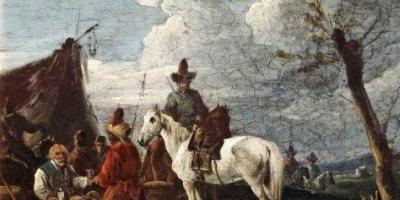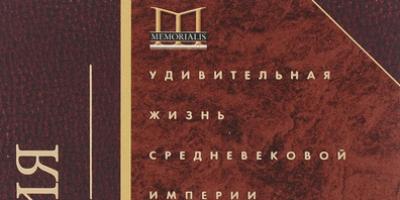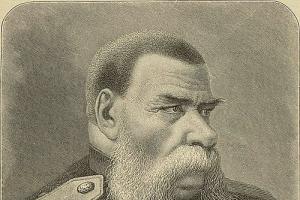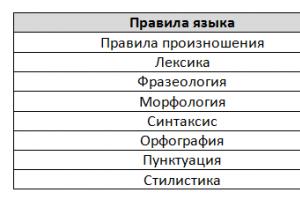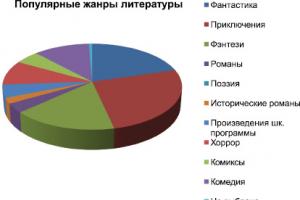At the end of the first decade of the 18th century. A powerful movement unfolded that embraced the Cossacks of the Don, partly the Zaporozhye Sich and the peoples of the Volga region. It was caused by an active attack by the state on the autonomy and self-government of the Don, demands for the return of fugitives, which violated the unwritten laws of life of the Cossacks. The reason for the riot was the actions of the expedition of Prince Yu. V. Dolgoruky, sent to search for and return the fugitives. In October 1707, one of Dolgoruky’s detachments was defeated by “newly arrived people” led by the ataman of the Trekhizbyanskaya village, Kondraty Bulavin, who became the leader of the “walking people”. By the spring of 1708, the movement expanded, covering Kozlovsky and Tambov districts, and the Pristansky town on Khoper became its center. In the capital of the Don Army, Cherkassk, the rebel army of Cossacks and peasants was divided into several detachments, one of which went to meet the tsarist troops, the other two to the Volga region. The main forces, together with Bulavin, moved to Azov. However, such a dispersal of forces backfired on the rebels. In July 1708, after two unsuccessful attempts to take Azov, a Cossack foreman from the “household Cossacks” attacked Bulavin’s kuren and ended his life,
In 1709-1710 Peasant uprisings swept through Voronezh, Saratov, Nizhny Novgorod, Yaroslavl, Kostroma, Vladimir and other provinces, but punitive forces prevailed everywhere. The anti-government movement of 1707-1710, which involved a large mass of the lower social classes, did not outgrow the scale of the Cossack revolt in its nature; its goal was mainly to restore the class privileges of the Cossacks.
Bashkir uprising (1705-1711)
In the first decade of the 18th century. Among the small peoples of the Volga region and the Urals, unrest continuously arose due to the unheard-of arbitrariness of Peter's administration, the seizure of the best lands, as well as the forced introduction of Orthodoxy. The uprising of the Bashkirs was caused by the introduction of new taxes in 1704 and the demand for the supply of horses for the army. The struggle against the authorities unfolded with particular force in 1705-1711. in Bashkiria. The reason for the uprising was the appearance of royal profit-makers in Bashkiria, who came to Ufa in 1704 to collect new taxes and conscript thousands of people into military service. The spontaneous indignation was used by the local Bai elite for their own interests. The uprising was led by large Bashkir bais Aldar Isekeev and Kuchuk Tyulekeev, who wanted to create their own khanate using the slogans of the Muslim religion. There were frequent cases of Bashkirs inciting hatred towards the Russian population living in the Urals: Russians were killed or sold into slavery. With great difficulty, by 1711 the tsarist authorities, with the help of troops, managed to suppress the uprising.
The case of Tsarevich Alexei
One of the most dramatic conflicts during the time of Peter I was associated with the name of Tsarevich Alexei, the heir to the throne. Being under the strong influence of his confessor Yakov Ignatiev, he condemned his father’s behavior and the reforms he carried out in the country. At the end of 1716, when relations between father and son reached a dead end, Alexei secretly fled from Russia to Austria under the patronage of Emperor Charles VI. In 1717, succumbing to the persuasion of Peter the Great's emissaries P. P. Tolstoy and A. I. Rumyantsev and believing in the tsar's promise to forgive his guilt, Alexei returned home, where he was taken into custody. The investigation revealed the prince's hostile plan towards Peter, which was to eliminate most of the reforms and return to old traditions. In June 1718, the Extraordinary Supreme Court, consisting of 127 people, sentenced Alexei to death, but the prince died in the casemate of the Peter and Paul Fortress before the sentence was carried out, apparently unable to withstand the terrible torture.
In the 18th century, the Russian Empire more than once became the scene of powerful social upheavals, among which the Bashkir uprising of 1705-1711 occupied a significant place. These events, separated from us by more than three centuries, clearly demonstrate the disastrous results that short-sighted and sometimes criminal policies pursued by local authorities can lead to. We will try to understand in this article what the specifics of the Bashkir uprising were and what were its causes.
Detonator for social explosion
Over the course of a long historical period, covering the entire previous 17th century, dissatisfaction grew among the population of Bashkiria with the attempts of the Russian authorities to instill Christianity among them in every possible way to the detriment of the national religion - Islam. Indignation was also caused by illegal extortions arranged by tsarist officials. Sometimes the situation became so tense that the Bashkirs took up arms.
This happened again in 1705, and the detonator for the social explosion was the decree of local tax officials M. Dokhov and A. Zhikharev. At a general meeting of representatives of the Bashkir clans, they announced the introduction of 72 new taxes, most of which were illegal and were supposed to fill their own pockets.
The last straw in the cup of patience
In addition, officials presented local residents with a number of religious demands. Thus, their decree stated that from now on all mosques should be built on the model of Christian churches, and mullahs must enter into marriages and record deaths in the presence of Orthodox priests. The Bashkirs were especially outraged by the requirement to pay a tax for each visit to prayer meetings.

Such claims were perceived as preparation for the forced Christianization of the people. To top it all off, they were obliged to supply 20 thousand horses and 4 thousand recruits for the needs of the army of Peter I, who was then fighting the Northern War. All these demands, the fulfillment of which was an unbearable burden for the bulk of the population, became the cause of the Bashkir uprising, which broke out in 1705 and raged for almost six years.
Social explosion
The beginning of events was also provoked by the arrival of Colonel A.S. Sergeev, notorious for his cruelty, in the Ufa district. Having gathered the elected elders, he put them in the position of hostages, announcing that he would execute everyone if 5 thousand horses were not handed over to him as soon as possible. Fearing the death of their compatriots, the Bashkirs submitted, but the arbitrariness of the authorities did not stop there. The collection of horses resulted in outright robbery of the already impoverished population.
As a result, residents driven to despair generally refused to obey local officials, stopped paying taxes and, as had happened more than once, took up arms. The place where the Bashkir uprising began was the Nogai Daruga (an administrative-territorial unit of those years), but very soon it covered the entire space from Kungur in the north to the Yaika River in the south, and from the Volga in the west to Tobol in the east.
A reckless step by the sovereign
The rebels were led by a resident of Ufa, Dumey Ishkeev. His troops carried out a number of attacks on the Zakamsky fortresses and were active in the area of the city of Solevarenny. It should be noted that, despite the military successes of the first stage of the Bashkir uprising, its organizers tried with all their might to avoid bloodshed, and for this purpose in the summer of 1706 they sent a petition to Peter I with a list of their grievances.

Ishkeev himself took her to St. Petersburg. The most respected representatives of the people went with him to the banks of the Neva. However, the sovereign not only did not consider it necessary to consider their demands, but ordered Ishkeev to be hanged, and the rest to be imprisoned as criminals and rebels. This clearly short-sighted step of his gave impetus to the continuation of the Bashkir uprising.
Separatist tendencies
The movement acquired its most widespread character in 1707, when residents of the Kazan and Nagai darugas united their efforts to defeat the military units of General P. S. Khokhlov sent to suppress the unrest, and then, having crossed the Kama, attacked the cities of Vyatka and Kungur districts.
At the same time, the feudal elite of the region announced their renunciation of Russian citizenship and attempted to create the Bashkir Khanate. In her endeavor, she counted on the help of the Crimean and Turkish khans, to whom ambassadors were immediately sent.
Broken Promises
At the beginning of the next 1708, new military units led by Prince P. I. Khovansky were sent to the areas affected by the uprising from the capital. His task was complicated by the fact that by that time the Bashkirs were closely interacting with the peasants and Cossacks of the Don, just like them, who had rebelled against bureaucratic arbitrariness. Realizing that full-scale military action would only aggravate the situation, the government, through its representative Khovansky, announced its readiness to make concessions.

In particular, it was promised to cancel illegal taxes imposed by local officials, as well as to consider all previously filed complaints. In response to this, the rebels agreed to lay down their arms, but since in reality the authorities did not fulfill any of their promises, their struggle continued.
War in Trans-Urals
In 1709, the center of military operations moved to the Trans-Urals, where local Karakalpaks joined the rebel detachments led by Urakai Yuldashbaev and Aldar Isyangildin. With their combined efforts, they carried out daring attacks on villages, factories, monasteries and forts located in the basins of the Techa, Iset and Miass rivers.
The chronicle of the events of the Bashkir uprising shows that at a certain stage, many Russian residents of the region joined the various ethnic groups that participated in the rebellion. Some of them had real reasons to hate the authorities, while others simply took the opportunity to take part in the robberies. But one way or another, their presence created additional difficulties for government troops.

Completion of large-scale military operations
In order to finally put an end to the rebels and normalize the situation, in 1710 the sovereign sent 2 fresh regiments to the Trans-Urals under the command of General I. Ya. Yakushin. The general, who by that time had quite a wealth of experience in pacifying rebellions, managed to attract local Kalmyks and even several thousand Bashkirs who wished to remain loyal to the tsarist government to suppress the uprising. Thanks to this, a significant superiority of forces was on his side. In addition, volunteer helpers from among the local residents had excellent knowledge of the terrain and with a high degree of probability could foresee the further actions of their rebellious compatriots.
As a result, the Bashkir uprising began to decline, and in the summer of 1710 the bulk of the rebels laid down their arms. Only their isolated isolated groups continued to resist, the liquidation of which did not pose a serious problem for government troops.
Concessions from the authorities
The last weak surge of anti-government activity was observed in 1711, when a small group of local residents tried to resume the fight in the central part of Bashkortostan. Their rebellion was also suppressed, but in order to prevent further protests, the authorities considered it advisable to make real concessions.

Thus, by decree of the tsar, the patrimonial rights of the Bashkirs were confirmed and a significant part of the previously established taxes was abolished. In addition, meeting with elected representatives of the population, the tsar's emissaries, on his behalf, condemned the violence and arbitrariness previously committed by the local authorities.
To top it all off, an open trial was held against tax officials Zhikharev and Dokhov, who, with their illegal actions, pushed the until then peaceful residents of the region to revolt. Both of them were sentenced to death, which greatly served to restore peace and tranquility.
However, the Bashkir uprising of 1705-1711. caused great human and material losses on both sides. Yesterday’s rebels regained Russian citizenship only in 1725, swearing allegiance to the widow of Peter the Great, Empress Catherine I.

Regarding the objective factors that prevented the rebels from achieving success, researchers point primarily to their ethnic heterogeneity. This uprising went down in history as the Bashkir one only because representatives of this ethnic group were its instigators and made up the majority of the participants. However, along with them, Karakalpaks, Kalmyks and a number of other peoples took an active part in the events of those years, each of whom pursued their own goals.
In addition, the fragmentation of individual rebel detachments and the almost complete absence of centralized leadership of military operations played into the hands of the tsarist troops, which largely reduced their effectiveness. And besides, the rebels, who were poorly armed and had not undergone any military training, were in many ways inferior to well-trained and sufficiently equipped government units.
Rebellion 1662-64. It began after the tsarist government banned the Bashkir feudal lords from raiding the Kalmyks and demanded the return of the prisoners they had captured, which infringed on the economic interests of the Bashkir nobility. The uprising was led by large feudal lords (Ish-Mukhammed, Konkas and Deveney Devletbaevs, Sary-Mergen and others), who sought to take advantage of the dissatisfaction of the popular masses with the seizure of Bashkir lands by the tsarist administration, abuses in the collection of yasak, etc. The political orientation of the feudal lords changed repeatedly. Some of them, having renounced Russian citizenship, looked for new patrons in the person of the Kalmyk taishas or the Siberian prince Kuchuk. The movement spread throughout Bashkiria and some neighboring districts. It reached a particular scale in the summer of 1662. Rebel detachments operated in the Ufa region, took the city of Kungur, besieged the Dolmatov Monastery and destroyed a number of Russian settlements in the Ufa and Kungur districts. The tsarist government sent significant military forces to fight the uprising. By the summer of 1664 the uprising was suppressed. The government partially satisfied the demands of the rebels: it confirmed the ban on the seizure of Bashkir lands, replaced the Ufa governor, promised to resolve old land disputes and punish those responsible for abuses in the collection of yasak, etc.
Rebellion 1681-83. The reason was rumors about the forced Christianization of the non-Russian population of the Volga and Urals regions. The uprising was led by the Bashkir feudal lords Seit Saafer (Sadiir), Ish-Mukhammed Devletbaev and others, who declared a “holy war” against the Russians and turned to the Kalmyks for help. The uprising began in the fall of 1681 and initially unfolded in the Zakamsk line area. In 1682 it spread to the Siberian road, especially its Trans-Ural part. Kalmyk detachments arrived in Bashkiria, which, under the guise of helping the rebels, tried to subjugate the Bashkir population, ravaged nomadic camps, captured prisoners, livestock, etc. In 1683 the rebels stopped fighting. The decisive role was played by the disappointment of the broad Bashkir masses in the movement and in the help of the Kalmyks, as well as the statement of the Russian government that it did not give any orders for the forced baptism of the Bashkirs.
Rebellion 1705-11. It was caused by the introduction of new taxes in 1704 and the requirement for the Bashkirs to supply horses for the Russian army, as well as the abuses that accompanied these events.
The uprising was led by large Bashkir feudal lords Aldar Isekeev and Kuchuk (Kusyum) Tyulekeev. Having renounced Russian citizenship, the Bashkir feudal elite made an attempt to create a Bashkir Khanate, bound by vassal relations with Turkey or the Crimean Khanate.
The movement that began in 1705-06 in the southern and northwestern parts of the region was soon suppressed. In 1707-08 it flared up again, covering a significant part of Bashkiria, especially its western regions, from where it spread to the Kazan district. In 1709-11, the center of the uprising moved to the east of the region, to the area of the Siberian and Nogai roads. In the fight against the uprising, the tsarist government used detachments of Kalmyks, who inflicted a serious defeat on the rebels in the summer of 1710. At the same time, the tsarism was forced to make some concessions: the size of quitrent payments was reduced, some lands were exempted from renting, etc.
Rebellion 1735-40. It was a reaction of the Bashkir population to the construction of fortresses by the tsarist government in Bashkiria, which was accompanied by the confiscation of land from the Bashkirs. The impetus for the uprising was the march from Ufa of a detachment of the Orenburg expedition (See Orenburg expedition) to the mouth of the river. Ori to build a city there. The rebels demanded a stop to the construction of fortresses. In 1735-36, the main focus of the uprising was Southwestern and Southern Bashkiria. In 1737-39, the center of movement moved to the eastern part of the region, within the Siberian Road. The uprising was led by large Bashkir feudal lords - Akhun Kilmyak Nurushev, Akay Kusyumov, warriors Yusup Arykov and Tyulkuchura Aldagulov, mullahs Bepenya Trupberdin and Yuldash Syuyarymbetov and others. The rebel detachments fought government troops, attacked fortified points, destroyed the settlements of Russian peasants, and also the non-Russian population who did not join the movement (Mishchars, Tatars, parts of the Bashkirs). The Bashkir feudal elite, counting on the support of the Kazakh Khan Abulkhair, insisted on renouncing Russian citizenship. In 1740 traffic broke out again within the Siberian road. The rebels grouped around the self-proclaimed Khan Karasakal (Minligul Yulaev), after whom the movement was called the Karasakal uprising. It was brutally suppressed. The main leaders were sentenced to death, and ordinary participants were fined. The tsarist government carried out a number of administrative reforms that brought the internal life of the Bashkir communities under the control of the Russian administration.
N. F. Demidova.
Uprising of 1755, Batyrsha's uprising. It was caused by increased feudal oppression, land oppression and forced Christianization carried out by the tsarist administration. A certain role in the preparation of the uprising was played by the appeal of Mullah Abdulla Aleev, nicknamed Batyrsh, who called on the Bashkirs, Tatars, Kazakhs, and Uzbeks to a “holy war.” However, in fact, Batyrsha did not lead the uprising, and the entire movement did not take place under his slogans. The uprising was spontaneous. It began on May 15 in the Burzyansky volost of the Nogai road (Southern Bashkiria) with the murder of the head of the mining party, the destruction of the Sapsal postal station and the cessation of service to the Isetsky tract. Under pressure from government troops, the most active rebels fled to the Kazakh steppes. In August, movement in this area resumed and captured a number of neighboring volosts. Some factories and postal pits (stations) were destroyed, and several local foremen were killed. By the end of August the movement had died down. The 3rd outbreak of uprising occurred in the area of the Osinskaya road (Northern Bashkiria) on August 27-28. The rebels killed the foreman and began to prepare for more active actions. However, local feudal lords opposed them, and the movement stopped. A major role in this was played by the policy of the tsarist government, aimed at splitting the rebels (forgiving all participants in the uprising who voluntarily surrendered, pitting the Tatars and Kazakhs against the Bashkirs and other non-Russian peoples, etc.). After the uprising, the oppression of tsarism in Bashkiria was somewhat weakened.
Lit.: Ustyugov N.V., Bashkir uprising of 1662-1664, in the collection: Historical Notes, vol. 24, M., 1947; his, Bashkir uprising of 1737-1739, M.-L., 1950; Essays on the history of the Bashkir Autonomous Soviet Socialist Republic, vol. 1, part 1, Ufa, 1956; Materials of the scientific session dedicated to the 400th anniversary of the annexation of Bashkiria to the Russian state, Ufa, 1958; From the history of Bashkiria, part 2, Ufa, 1963; Lebedev V.I., Bashkir uprising of 1705-1711, in the collection: Historical Notes, [vol.] 1, M., 1937; Akmanov I.G., Bashkir uprising of 1704-1711, in the book: Collection of scientific works of graduate students of the Faculty of History of Moscow State University, M., 1963; History of the USSR, from ancient times to the present day, vol. 3, M., 1967.
I. A. Bulygin.
- - revolutionary uprisings of sailors and soldiers of Kronstadt during the revolution of 1905-07. The uprising of 1905 was preceded by revolutionary unrest in the garrison in the summer and spontaneous uprisings in September...
St. Petersburg (encyclopedia)
- - popular movement against Russian colonial policy. tsarism in the region. The dissatisfied masses raised the famous B.V. in history, which took place in the 16th-18th centuries: 1572, 1616,1645, 1662-64, 1681-84, 1704-06, 1707-08, 1709-10, 1711, 1735-36 ,1737-38,1739-40,1755-56...
Ural Historical Encyclopedia
- - the highest form of class struggle in a society whose mode of production was based on slavery...
Dictionary of Antiquity
- - adv. uprisings in Iran in 1848-52, directed against feudal building, as well as objectively and against the beginning enslavement of Iran by foreigners. capital...
- - popular uprisings in Gilan against Safavid rule. Gilan khanates of Biye Pas and Biye Pish in the 16th century. were forced to recognize vassal dependence on the Safavid state. Anti-Safavid uprising in Gilan...
Soviet historical encyclopedia
- - cross. uprisings in Sweden region Dalarna in the 20-30s. 16th century D.v. were caused by increased tax oppression in the first decade of the reign of Gustav I Vasa, high prices, as well as the machinations of the opposition...
Soviet historical encyclopedia
- - anti-tour. and antifeud. Druze uprising in the region Jebel Druz at the end 19 - beginning 20th centuries The general reasons for the uprisings were: on the one hand, the difficult situation of the Druze peasantry, deprived of land by the Druze feud....
Soviet historical encyclopedia
- - popular uprisings in 1848-52 in Iran against the feudal system and, objectively, against the beginning of the enslavement of the country by foreign capital...
- - Uprising 1662-64...
Great Soviet Encyclopedia
- - 1905, 1906, 1907, armed uprisings of sailors, soldiers and workers in Vladivostok during and after the Revolution of 1905-07...
Great Soviet Encyclopedia
- - 1852-53, 1857-58, 1861-1862, anti-feudal and national liberation peasant uprisings in Herzegovina, which was under Turkish rule. Enjoyed the support of Montenegro...
Great Soviet Encyclopedia
- - popular uprisings in the Swedish region. Dalarna: first, second, third...
Great Soviet Encyclopedia
- - 1866-1869, 1896-97, people's liberation uprisings in Crete against Turkish feudal and national oppression...
Great Soviet Encyclopedia
- - popular anti-feudal uprisings in Iran under the leadership of the Babis in 1848-52, objectively also directed against the beginning of the enslavement of Iran by foreign capital...
- - 1146-47 - folk. The destruction of the courtyards of the princely administration by the rebels. The murder of Prince Igor Olgovich, the failure of the Olgovichs’ attempt to gain a foothold in Kyiv...
Large encyclopedic dictionary
- - 1866-69 - 1896-1897, on the island. Crete, anti-Ottoman, under the slogan of reunification with Greece...
Large encyclopedic dictionary
"Bashkir uprisings of the 17th-18th centuries." in books
II. Bashkir steppes
From the book Leo Tolstoy author Shklovsky Viktor BorisovichII. Bashkir steppes Once upon a time, after the Pugachev uprising, the Bashkirs, participants in the battles of Salavat Yulaev, Pugachev’s ally in the war with Catherine, were exiled to Karalyk. The uprising is long over. It remains only in songs. Fifty years ago, Bashkir armed with bows
4. Progress of the uprising
From the book At the Heart of Hell: Notes Found in the Ashes Near the Ovens of Auschwitz author Gradovsky Zalman4. Progress of the uprising According to the new plan, the uprising was supposed to begin at crematoriums IV and V and begin quietly. It was planned to bring weapons to crematoriums II and III in a cart for transporting coke, but even this did not work out - probably due to the betrayal of the Poles or Germans from
During the days of the uprising
From the book Book 3. Between two revolutions author Bely AndreyDuring the days of the uprising, Serafima Pavlovna Remizova was friends with Gippius; from her I heard: Savinkov, the head of the fighting Social Revolutionaries, led Kalyaev’s bomb; his head is assessed, and he lives in St. Petersburg, secretly visiting the Remizovs39 and complaining to them about a hallucination: the shadow of Kalyaev appeared to him; his
Bashkir
From the book Your Dumpling House author Maslyakova Elena VladimirovnaProgress of the uprising
From the book Scrolls from Ashes author Polyan Pavel MarkovichProgress of the uprising According to the new plan, the uprising was supposed to begin at crematoriums IV and V, and begin quietly. It was planned to bring weapons to crematoriums II and III in a cart for transporting coke, but even this did not work out - probably due to the betrayal of the Poles or Germans from
Bashkir colonels of Pugachev - Kinzya Arslanov and Salavat Yulaev
From the book Emelyan Pugachev and his associates author Limonov Yuri AlexandrovichBashkir colonels of Pugacheva - Kinzya Arslanov and Salavat Yulaev During the Peasant War of 1773–1775. The uprising also engulfed many national regions of the Russian Empire, primarily Bashkiria and Tataria. The indigenous population of these areas, who suffered severely from
Two uprisings
From the book Pirates, Corsairs, Raiders author Mozheiko IgorTwo uprisings Kamchatka lay on the edge of Russia. The route there from Yakutsk took months, and at some times of the year it was completely closed. They used it mainly to exile people from whom they had to get rid of forever. As Russia expanded
UPRISING
From the book World History: in 6 volumes. Volume 3: The World in Early Modern Times author Team of authorsUPRISING It is impossible to find a text in which the 17th century. would not be called "rebellious". Indeed, during this period the country was especially often shaken by popular disturbances, the origins of which may lie in the Time of Troubles. It brought, on the one hand, hardship and destruction, on the other -
§ 6. PROGRESS OF THE UPRISING
From the book History of Belarus author Dovnar-Zapolsky Mitrofan Viktorovich§ 6. PROGRESS OF THE UPRISING The course of the uprising of 1863 is of no interest to us. His interest is in the Warsaw ups and downs that preceded the open protests of 63. These are endless disputes and competitions between the “whites” and the “reds” (aristocratic and democratic movements
Two uprisings
From the book Nero by Sizek EugeneTwo uprisings Assimilation was not always welcome. The spirit of resistance in some provinces and the failures of the imperial administration, sometimes impressive, indicate an inability to understand local conditions, which was the cause of major uprisings. Yes, I got up
Kalmyk, Bashkir, Crimean Tatar and other irregular regiments as part of Cossack corps and detachments
From the book Cossacks against Napoleon. From Don to Paris author Venkov Andrey VadimovichKalmyk, Bashkir, Crimean Tatar and other irregular regiments as part of Cossack corps and detachments. Numerous small nations that became part of Russia in the 17th-18th centuries owed military service to their new homeland and, if necessary, fielded irregular
3. Progress of the uprising
From the book A Short Course in the History of Russia from Ancient Times to the Beginning of the 21st Century author Kerov Valery Vsevolodovich3. Progress of the uprising The uprising covered a vast territory: the Orenburg region, the Urals, the Urals, the Lower and Middle Volga regions, and went through several stages: 3.1. First period (September 1773 – March 1774). The uprising began on September 17 with the performance of a small detachment of Cossacks,
Bashkir uprisings of the 17th-18th centuries.
From the book Great Soviet Encyclopedia (BA) by the author TSBWe are from the uprising!
From the book Chronicle of Diving Time author Prokhanov Alexander AndreevichWe are from the uprising! September - October 1997, No. 39 Do you remember these faces on the balcony of the House of Soviets among the flags of the Uprising? The barely visible shadows of the barricades in the drizzling rain, baked potatoes in the fire. Women's screams and swings of clubs at the Barrikadnaya, night sitting at
Uprisings
From the book Systems of Power [Conversations on Global Democratic Uprisings and New Challenges to the American Empire] by Noam ChomskyUprisings Cambridge, Massachusetts (January 17, 2012) Mohamed Bouazizi, a young street vendor in a small town in Tunisia, committed self-immolation in despair. This led to a spontaneous uprising in Tunisia, and then in Egypt and other parts of the Arab Middle
In the first decade of the 17th century. Among the small peoples of the Volga region and the Urals - the Bashkirs, Mari, Tatars and Chuvashs - there was continuous unrest associated with the unheard-of arbitrariness of Peter the Great's administration, the displacement of the local population from their inhabited places, the seizure of the best lands, as well as the forcible introduction of Orthodoxy. The struggle against the authorities launched by the Bashkirs in 1705-1711 was particularly powerful.
The immediate cause of this uprising was the appearance of royal profit-makers in Bashkiria, who came to Ufa in 1704 to exact new taxes and conscript thousands of people for military service. The spontaneous indignation was used by the local Bai elite in their own interests: they sought to break away from Moscow and become subject to the Turkish Sultan or Crimean Khan, using the slogans of the Muslim religion. There were frequent cases of Bashkirs inciting hatred towards the Russian population living in the Urals - as a result, Russians were killed, maimed, and sold into slavery. With great difficulty, the tsarist authorities, with the help of regular troops, managed to suppress the uprising by 1711.
Other entries
06/10/2016. Uprising led by Kondraty Bulavin (1707-1710)
At the end of the first decade of the 17th century. A powerful Cossack movement unfolded, covering the Don Army Region, the Russian Don region, part of the Volga region and partly the Zaporozhye Sich on the Dnieper. Its reasons were rooted...
06/10/2016. The case of Tsarevich Alexei
One of the most acute and dramatic political conflicts of the time of Peter I was associated with Tsarevich Alexei, his eldest son from his first marriage to Evdokia Lopukhina. Alexey, who was under strong...
06/10/2016. Ideological and political struggle in the era of palace coups
The era of palace coups (1725-1762) occupies an important place in the history of socio-political thought in Russia. One of the central episodes of this period is the attempt of the Supreme Privy Council in 1730 to change...
06/10/2016. Peasant war led by E. I. Pugachev (1773-1775)
In 1771, unrest swept the lands of the Yaik Cossacks. Unlike the local social uprisings that preceded them, this uprising of the Cossacks in the Urals was already a direct prologue to the largest social...
06/10/2016. Socio-political thought and social movements in the era of enlightened absolutism
In the second half of the 18th century. there is an emergence and gradual formation of the main trends of Russian social and political thought, which received their final form in the next, 19th century.…
To the Volga, from the middle reaches of the Yaik to Kazan, Vyatka and Kungur
|
At the beginning of 1708, the government sent punitive forces against the rebels, led by P. I. Khovansky. In April-May 1708, the Bashkirs established contact with the rebel peasants and Cossacks of the Don led by K. A. Bulavin. In May 1708, the government again turned to the Bashkirs with a proposal to begin negotiations. Khovansky, on behalf of the government, promised to cancel the demands of the “profit-makers,” forgive the rebels and consider complaints about the arbitrariness of local authorities. The Bashkirs agreed to stop fighting. But the authorities violated the terms of the agreement. Uprising in Trans-Urals3rd stage. In the spring of 1709, the uprising resumed on the territory of the Siberian and eastern parts of the Nogai roads. A struggle unfolded in the Trans-Urals under the leadership of Aldar Isyangildin and Urakai Yuldashbaev. The rebels established contact with the Karakalpaks and together with them attacked forts, settlements, factories, monasteries and villages located on Bashkir lands in river basins |

